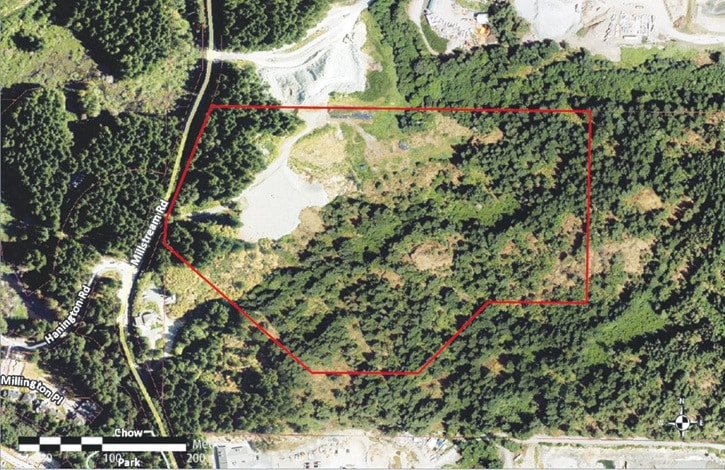A project decades in the making is beginning to see the light at the end of the tunnel. But getting through that tunnel could still be a long process.
The Millstream Meadows site in Highlands is entering the final stages of remediation but still could have another five years before the property will be ready for sale.
“We don’t know exactly how it’s going to turn out,” said Highlands Mayor Ken Williams. “It’s very preliminary.”
Millstream Meadows is a 32-acre site that was used as an unregulated dumping site for septage waste from approximately 1941 to 1985.
Initially the site was privately owned but the province acquired and operated it for a brief period in 1974. It came into the CRD’s possession in 1984 before it was closed in 1985.
In 2008, the CRD and the province began the remediation process after contaminations were identified and removed roughly 76,000 metric tonnes of soil from the site. Contaminates found included metals, hydrocarbons, household debris, construction refuse, auto parts, PCBs, sewage and oil waste.
The goal of this remediation project, which has seen cooperation between the province, the CRD and the District of Highlands, is to see the property returned to public use.
But the CRD must acquire a certificate of compliance from the B.C. Ministry of Environment that will deem the site safe for use before the property can be sold.
To comply with those environmental and rezoning requirements the next phase of remediation will require an approved professional to complete investigations and risk-assessment activities, and submit applications to the Ministry of Environment.
Last week the CRD Board voted in favour of entering into that next stage and allowing staff to begin the competitive processes of receiving bids for environmental consulting services and detailed site investigations.
CRD board chair Nils Jensen said once a consultant has been selected, that group would be able to determine an updated timeline for the completion of the project once assessments have been done.
Those assessments will also help to determine when the CRD will be able to sell the property, which is currently predicted for 2020, and which portions of the property they will be able to lease out in the interim.
An overall budget for the project was estimated at $10.5 million. To date $9 million has been spent with an estimated $2.7 million in outstanding costs still projected.
“We hope to recoup most of that.” Jensen said the CRD plans on doing that with income from leasing and eventually the sale of the property, adding “it’ll depend on market conditions at the time.”
Those costs have been shared, with the CRD contributing roughly 60 per cent and the provincial government contributing the other 40 per cent.
“This is an excellent example of different levels of government working very collaboratively to correct a historical situation,” Jensen said. “It’s been a very positive experience.”
Williams said the Highlands council was asked by the CRD to begin moving forward with a rezoning application that could see the land redeveloped for commercial or light industrial use.
“Remediation has to be set to much higher standards for residential use.” Williams said the application was still in its early stages and the next steps will be for council to review the site before it is passed onto the committee level.
“This is a comprehensive approach,” he said, adding that “it’s going to be a long-term plan.”
The District is also looking at another rezoning application for an adjacent property and plans to develop a thorough strategy for the entire area.
“Everyone in the region seems to be on the same page with this one,” Williams said.
katie@goldstreamgazette.com
